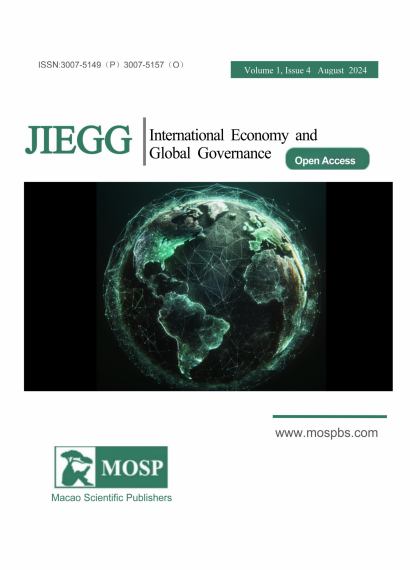-
Mackinnon, A. (2008). Chinese strategy: Is it crossverging, converging or transverging to Western systems? Management Decision, 46(2), 173-186. https://doi.org/10.1108/00251740810854104
-
So, A. Y. (2014). The Chinese model of development: Characteristics, interpretations, implications. Perspectives on Global Development and Technology, 13(4), 444-464. https://doi.org/10.1163/15691497-12341311
-
Amiri, S., & Woodside, J. M. (2017). Emerging markets: The impact of ICT on the economy and society. Digital Policy, Regulation and Governance, 19(5), 383-396. https://doi.org/10.1108/DPRG-04-2017-0013
-
Epaulard, A., & Pommeret, A. (2016). Financial integration, growth and volatility. Pacific Economic Review, 21(3), 330-357. https://doi.org/10.1111/1468-0106.12177
-
Ghose, A., & Das, S. (2013). Government size and economic growth in emerging market economies: A panel co-integration approach. Macroeconomics and Finance in Emerging Market Economies, 6(1), 14-38. https://doi.org/10.1080/17520843.2012.697075
-
Bremmer, I., & Roubini, N. (2011). A G-Zero world: The new economic club will produce conflict, not cooperation. Foreign Affairs, 90(2), 2-7.
-
Dittmer, L. (2002). East Asia in the new era in world politics. World Politics, 55(1), 38-65. https://www.jstor.org/stable/25054209
-
Morse, E. (1976). Modernization and the transformation of international relation. New York, NY: The Free Press.
-
Eichengreen, B. (2011). Exorbitant privilege: The decline of the dollar and the future of the international monetary system. Oxford: Oxford University Press.
-
Feigenbaum, E. A. (2010). India’s rise, America’s interest. Foreign Affairs, 89(2), 76-91.
-
He, Q., Xue, C., & Zhu, C. (2017). Financial development and patterns of industrial specialization: Evidence from China. Review of Finance, 21(4), 1593-1638. https://doi.org/10.1093/rof/rfw024
-
Ikenberry, G. J. (2008). The rise of China and the future of the West. Foreign Affairs, 87(1), 23-37. https://api.semanticscholar.org/CorpusID:157332030
-
Spero, J. E. (1981). The politics of international economics relations. New York, NY: St. Martin’s Press.
-
Jin, J., Wang, Y., & Vanhaverbeke, W. (2014). Patterns of R&D internationalisation in developing countries: China as a case. International Journal of Technology Management, 64(2/3/4), 276-302. https://doi.org/10.1504/IJTM.2014.059947
-
Kahler, M. (2013). Rising powers and global governance: Negotiating change in a resilient status quo. International Affairs, 89(3), 711-729. https://doi.org/10.1111/1468-2346.12041
-
Kyung, K. Y., Ravichandran, S., & Susela, D. (2024). Capital market effects of corporate transparency and sustainability: Evidence from an emerging economy. Journal of Asia Business Studies, 18(3), 688-711. https://doi.org/10.1108/JABS-02-2023-0071
-
Ratanavararak, L. (2018). The impact of financial and trade integration on business cycles in emerging markets. International Journal of Monetary Economics and Finance, 11(3), 215-223. https://doi.org/10.1504/IJMEF.2018.093789
-
Nayyar, D., & Nayyar, G. (2024). Made in India: Industrial policy in a changing world. Journal of Industry, Competition and Trade, 24(1). https://doi.org/10.1007/s10842-024-00417-6
-
Blanchard, O. (2021). Macroeconomics (8th ed.). London: Pearson Education.
-
Krugman, P., Obstfeld, M., & Melitz, M. (2011). International economics: Theory and policy (9th ed.). Massachusetts: Addison-Wesley.
-
Lane, P. R. (2003). Business cycles and macroeconomic policy in emerging market economies. International Finance, 6(1), 89-108. https://doi.org/10.1111/1468-2362.00109
-
Poulin, M. (2021). Comparative analysis of the economic structure of the socialist market economy of China and the New Economy Policy. International Critical Thought, 11(4), 519-534. https://doi.org/10.1080/21598282.2021.2007502
-
Schroeder, R. (2022). Social thought from the global south: A comparative-historical view from Xi’s China and Modi’s India. New Global Studies, 17(3), 269-289. https://doi.org/10.1515/ngs-2022-0017
-
Vernon, R. (1971). Sovereignty at bay: The multinational spread of U.S. enterprises. New York, NY: Basic Books.
-
Cooper, R. (1968). The economics of interdependence: Economic policies in the Atlantic community. New York, NY: McGraw Hill.
-
Gilpin, R. (2001). Global political economy. Oxford: Princeton University Press.
-
Choi, S., & Shim, M. (2019). Financial vs. policy uncertainty in emerging market economies. Open Economies Review, 30(2), 297-318. https://doi.org/10.1007/s11079-018-9509-9
-
Phelan, S. (2013). The rise and fall of neo-liberalism: The collapse of an economic order? Critical Discourse Studies, 10(1), 117-119. https://doi.org/10.1080/17405904.2012.757866
-
Hove, S., Mama, A. T., & Tchana, F. T. (2016). Monetary policy and commodity terms of trade shocks in emerging market economies. Economic Modelling,49,53-71. https://doi.org/10.1111/1468-0106.12177
-
Sharma, S. D. (2014). ‘India rising’ and the mixed blessings of globalization. India Quarterly, 70(4), 283-297. https://doi.org/10.1177/0974928414545925
-
Hymer, S. H. (1976). The international operations of national firms: A study of direct foreign investment. Cambridge, MA: MIT Press.
-
Lynn, S. R. (2002). Economic development: Theory and practice for a divided world. London: Pearson Education.
-
Strange, S. (1994). States and markets. Shanghai: Shanghai People’s Publishing House.
-
Trancoso, T. (2014). Emerging markets in the global economic network: Real(ly) decoupling? Physica A: Statistical Mechanics and Its Applications, 395, 499-510. https://doi.org/10.1016/j.physa.2013.10.031
-
Widmaier, W. (2015). The power of economic ideas – through, over and in – political time: The construction, conversion and crisis of the neoliberal order in the US and UK. Journal of European Public Policy, 23(3), 338-356. https://doi.org/10.1080/13501763.2015.1115890
-
Wojczewski, C. (2016). China’s rise as a strategic challenge and opportunity: India’s China discourse and strategy. India Review, 15(1), 22-60. https://doi.org/10.1080/14736489.2015.1092748

